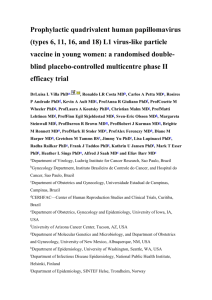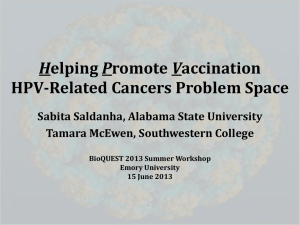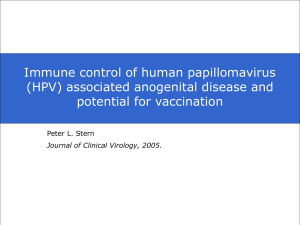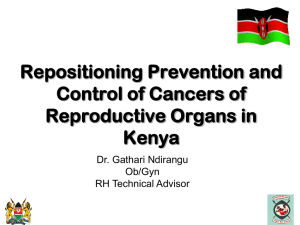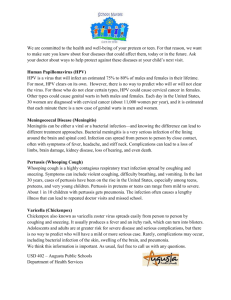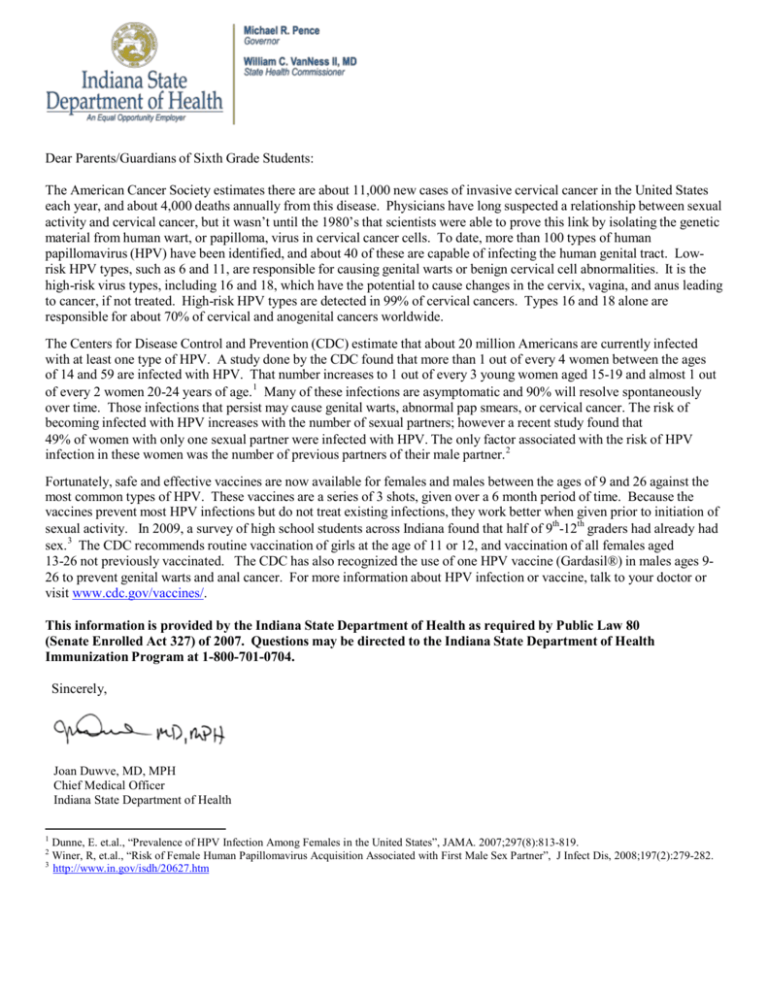
Dear Parents/Guardians of Sixth Grade Students:
The American Cancer Society estimates there are about 11,000 new cases of invasive cervical cancer in the United States
each year, and about 4,000 deaths annually from this disease. Physicians have long suspected a relationship between sexual
activity and cervical cancer, but it wasn’t until the 1980’s that scientists were able to prove this link by isolating the genetic
material from human wart, or papilloma, virus in cervical cancer cells. To date, more than 100 types of human
papillomavirus (HPV) have been identified, and about 40 of these are capable of infecting the human genital tract. Lowrisk HPV types, such as 6 and 11, are responsible for causing genital warts or benign cervical cell abnormalities. It is the
high-risk virus types, including 16 and 18, which have the potential to cause changes in the cervix, vagina, and anus leading
to cancer, if not treated. High-risk HPV types are detected in 99% of cervical cancers. Types 16 and 18 alone are
responsible for about 70% of cervical and anogenital cancers worldwide.
The Centers for Disease Control and Prevention (CDC) estimate that about 20 million Americans are currently infected
with at least one type of HPV. A study done by the CDC found that more than 1 out of every 4 women between the ages
of 14 and 59 are infected with HPV. That number increases to 1 out of every 3 young women aged 15-19 and almost 1 out
of every 2 women 20-24 years of age. 1 Many of these infections are asymptomatic and 90% will resolve spontaneously
over time. Those infections that persist may cause genital warts, abnormal pap smears, or cervical cancer. The risk of
becoming infected with HPV increases with the number of sexual partners; however a recent study found that
49% of women with only one sexual partner were infected with HPV. The only factor associated with the risk of HPV
infection in these women was the number of previous partners of their male partner. 2
Fortunately, safe and effective vaccines are now available for females and males between the ages of 9 and 26 against the
most common types of HPV. These vaccines are a series of 3 shots, given over a 6 month period of time. Because the
vaccines prevent most HPV infections but do not treat existing infections, they work better when given prior to initiation of
sexual activity. In 2009, a survey of high school students across Indiana found that half of 9th-12th graders had already had
sex. 3 The CDC recommends routine vaccination of girls at the age of 11 or 12, and vaccination of all females aged
13-26 not previously vaccinated. The CDC has also recognized the use of one HPV vaccine (Gardasil®) in males ages 926 to prevent genital warts and anal cancer. For more information about HPV infection or vaccine, talk to your doctor or
visit www.cdc.gov/vaccines/.
This information is provided by the Indiana State Department of Health as required by Public Law 80
(Senate Enrolled Act 327) of 2007. Questions may be directed to the Indiana State Department of Health
Immunization Program at 1-800-701-0704.
Sincerely,
Joan Duwve, MD, MPH
Chief Medical Officer
Indiana State Department of Health
1
Dunne, E. et.al., “Prevalence of HPV Infection Among Females in the United States”, JAMA. 2007;297(8):813-819.
Winer, R, et.al., “Risk of Female Human Papillomavirus Acquisition Associated with First Male Sex Partner”, J Infect Dis, 2008;197(2):279-282.
3
http://www.in.gov/isdh/20627.htm
2
Human Papillomavirus (HPV) Fact Sheet
Wh at is g en ital H PV in f ec tion ?
Genital human papillomavirus (also called HPV) is the most common sexually transmitted infection (STI).
There are more than 40 HPV types that can infect the genital areas of males and females. These HPV types can
also infect the mouth and throat. Most people who become infected with HPV do not even know they have it.
Wh at a r e th e si gn s, s y mp to ms an d p ot en t ial h eal th p rob le ms o f HPV?
Most people with HPV do not develop symptoms or health problems from it. In 90% of cases, the body’s
immune system clears HPV naturally within two years.
•
•
But sometimes, certain types of HPV can cause genital warts in males and females.
Other HPV types can cause cervical cancer. These types can also cause other, less common but serious
cancers, including cancers of the vulva, vagina, penis, anus, and head and neck (tongue, tonsils and
throat).
How d o p eop l e g et H PV?
HPV can be spread through genital contact, oral sex, vaginal sex or anal sex, even when the infected partner has
no signs or symptoms.
A person can have HPV even if years have passed since he or she had sexual contact with an infected person.
Most infected persons do not realize they are infected or that they are passing the virus on to a sex partner.
Very rarely, a pregnant woman with genital HPV can pass HPV to her baby during delivery.
How d oes H PV cau s e gen i tal w a rts an d c an ce r?
HPV can cause normal cells on infected skin to turn abnormal. Most of the time, you cannot see or feel these
cell changes. In most cases, the body fights off HPV naturally, but in cases when the body does not fight off
HPV, HPV can cause visible changes in the form of genital warts or cancer. Warts can appear within weeks or
months after getting HPV. Cancer often takes years to develop after getting HPV.
How co mmon ar e H PV an d r ela t ed d is ea ses?
HPV (the virus). Approximately 20 million Americans are currently infected with HPV. Another 6 million
people become infected each year. HPV is so common that at least 50% of sexually active men and women get
it at some point in their lives.
Genital warts. About 1% of sexually active adults in the U.S. have genital warts at any one time.
Cervical cancer. Each year, about 12,000 women get cervical cancer in the U.S.
Other cancers that can be caused by HPV. Each year in the U.S., there are about:
•
•
•
•
4,700 women who get vulvar or vaginal cancer
1,000 men who get penile cancer
2,700 women and 1,700 men who get anal cancer
2,300 women and 9,000 men who get head and neck cancers. [Note: although HPV is associated with
some of head and neck cancers, most of these cancers are related to smoking and heavy drinking.]
Human Papillomavirus (HPV) Fact Sheet (April 2013)
Page 1 of 2
How can p eop le p r ev en t H PV ?
There are several ways that people can lower their chances of getting HPV:
•
Vaccines can protect males and females against some of the most common types of HPV. These
vaccines are given in three shots. It is important to get all three doses to get the best protection. The
vaccines are most effective when given before a person's first sexual contact, when he or she could be
exposed to HPV.
o Girls and women: Two vaccines (Cervarix and Gardasil) are available to protect females against
the types of HPV that cause most cervical cancers. One of these vaccines (Gardasil) also protects
against most genital warts. Both vaccines are recommended for 11 and 12 year-old girls, and for
females 13 through 26 years of age, who did not get any or all of the shots when they were
younger. These vaccines can also be given to girls as young as 9 years of age.
o Boys and men: One available vaccine (Gardasil) protects males against most genital warts. This
vaccine is available for boys and men, 9 through 26 years
•
People can also lower their chances of getting HPV by being in a faithful relationship with one partner;
limiting their number of sex partners; and choosing a partner who has had no or few prior sex partners.
But even people with only one lifetime sex partner can get HPV. And it may not be possible to
determine if a partner who has been sexually active in the past is currently infected.
For those who choose to be sexually active, condoms may lower the risk of HPV. Condoms may also
lower the risk of developing HPV-related diseases, such as genital warts and cervical cancer. But HPV
can infect areas that are not covered by a condom - so condoms may not fully protect against HPV.
•
Wh er e can I g et mo r e in f or ma tion ?
Your child’s doctor is a good source of information about HPV disease and prevention. Or, visit the CDC
website at:
http://www.cdc.gov/std/HPV/STDFact-HPV.htm
Information courtesy of the Centers for Disease Control and Prevention (CDC)
Human Papillomavirus (HPV) Fact Sheet (April 2013)
Page 2 of 2




